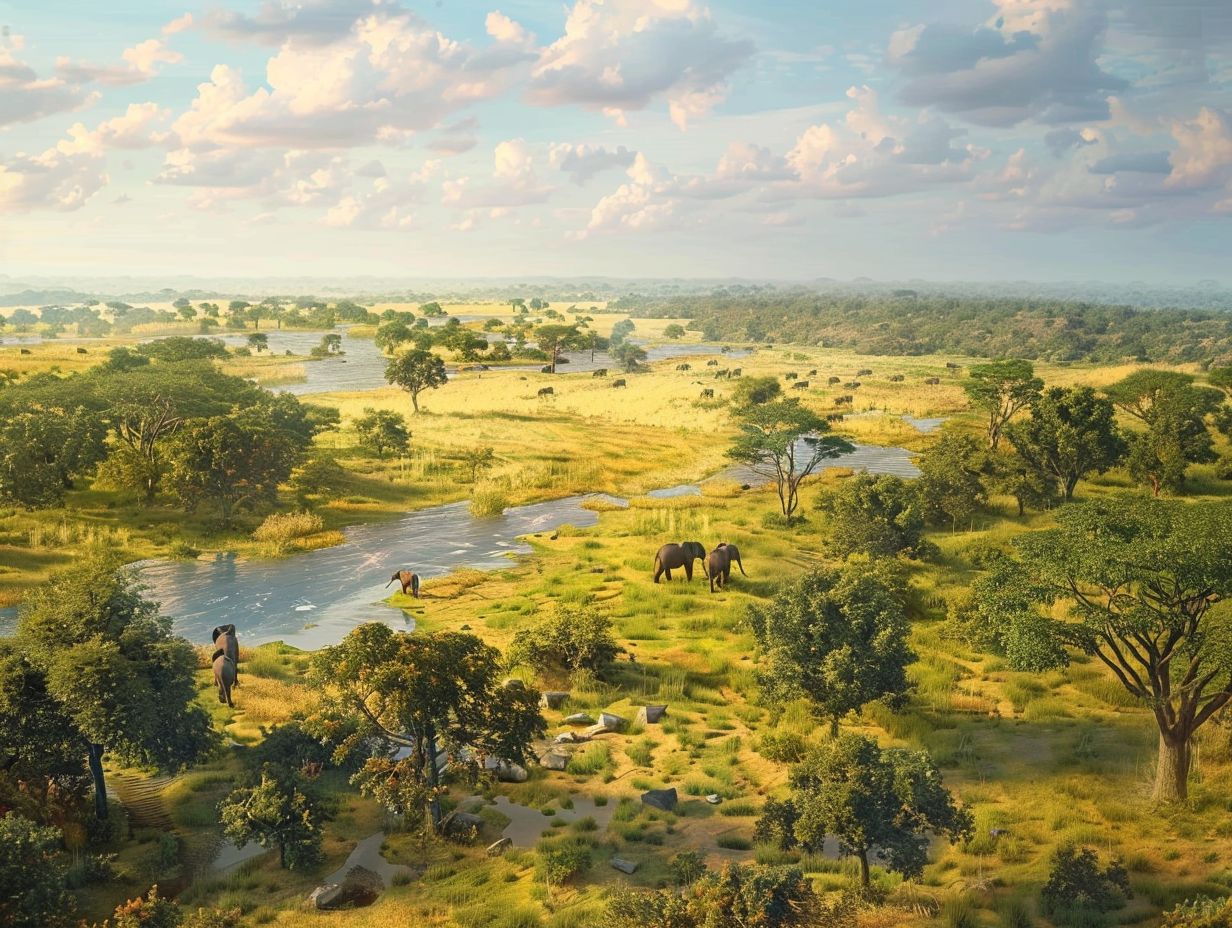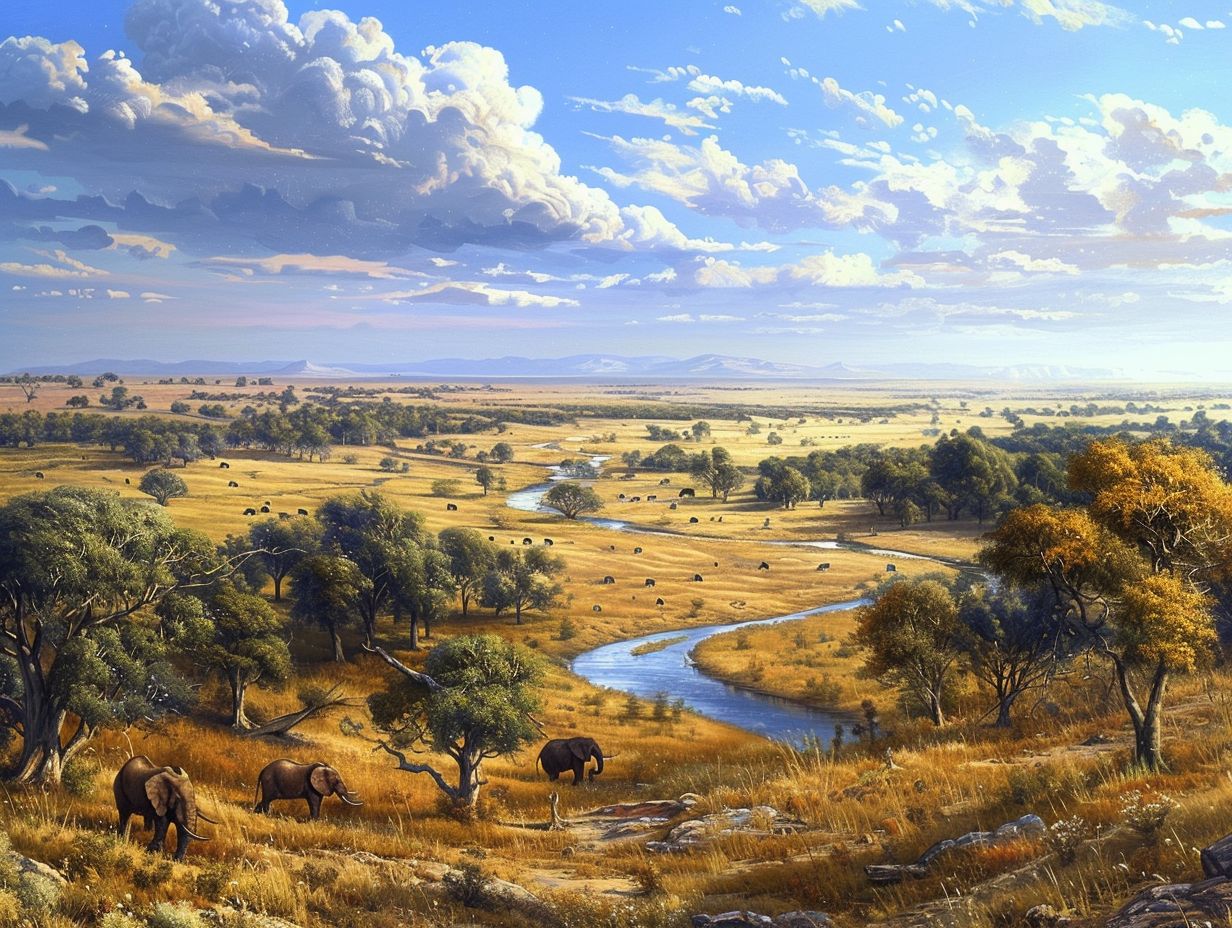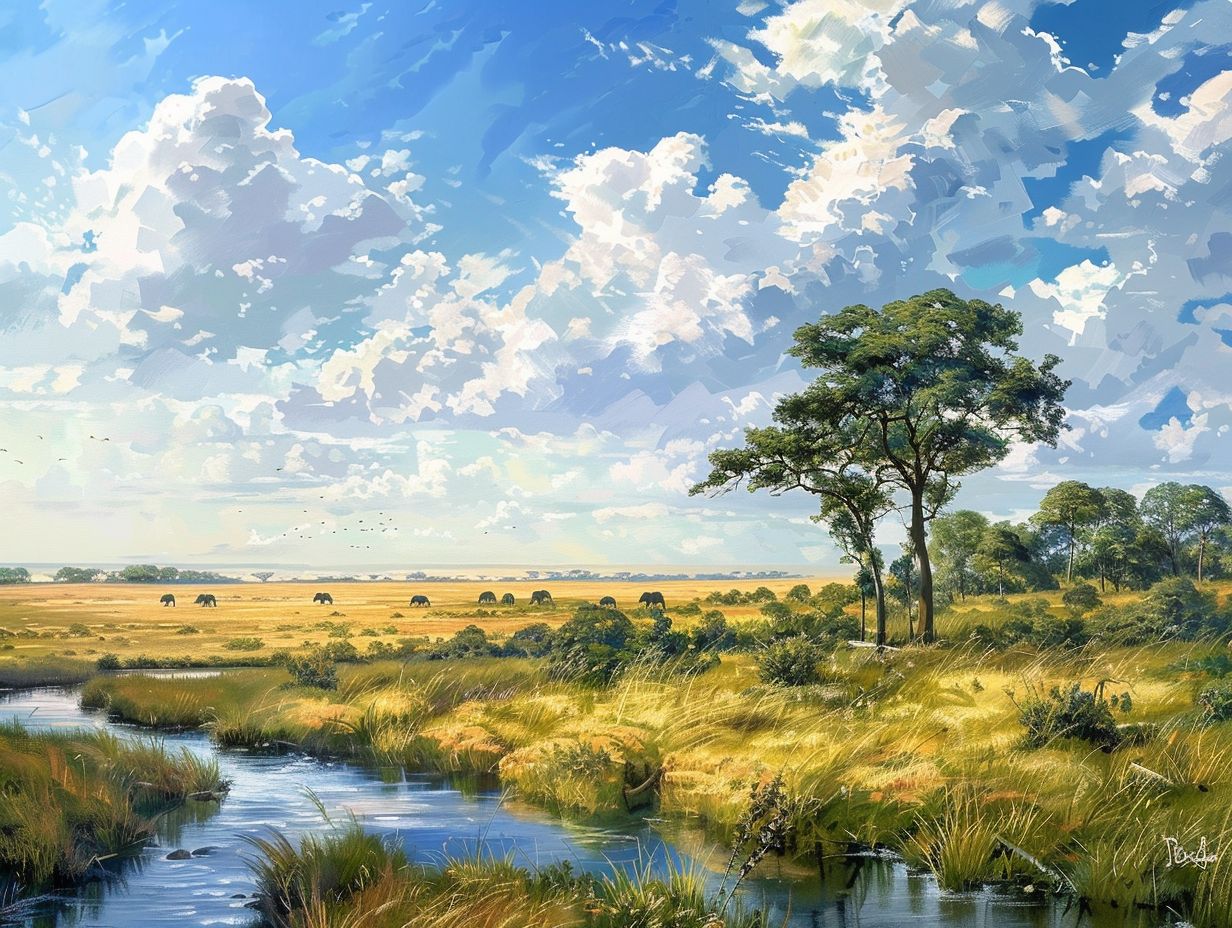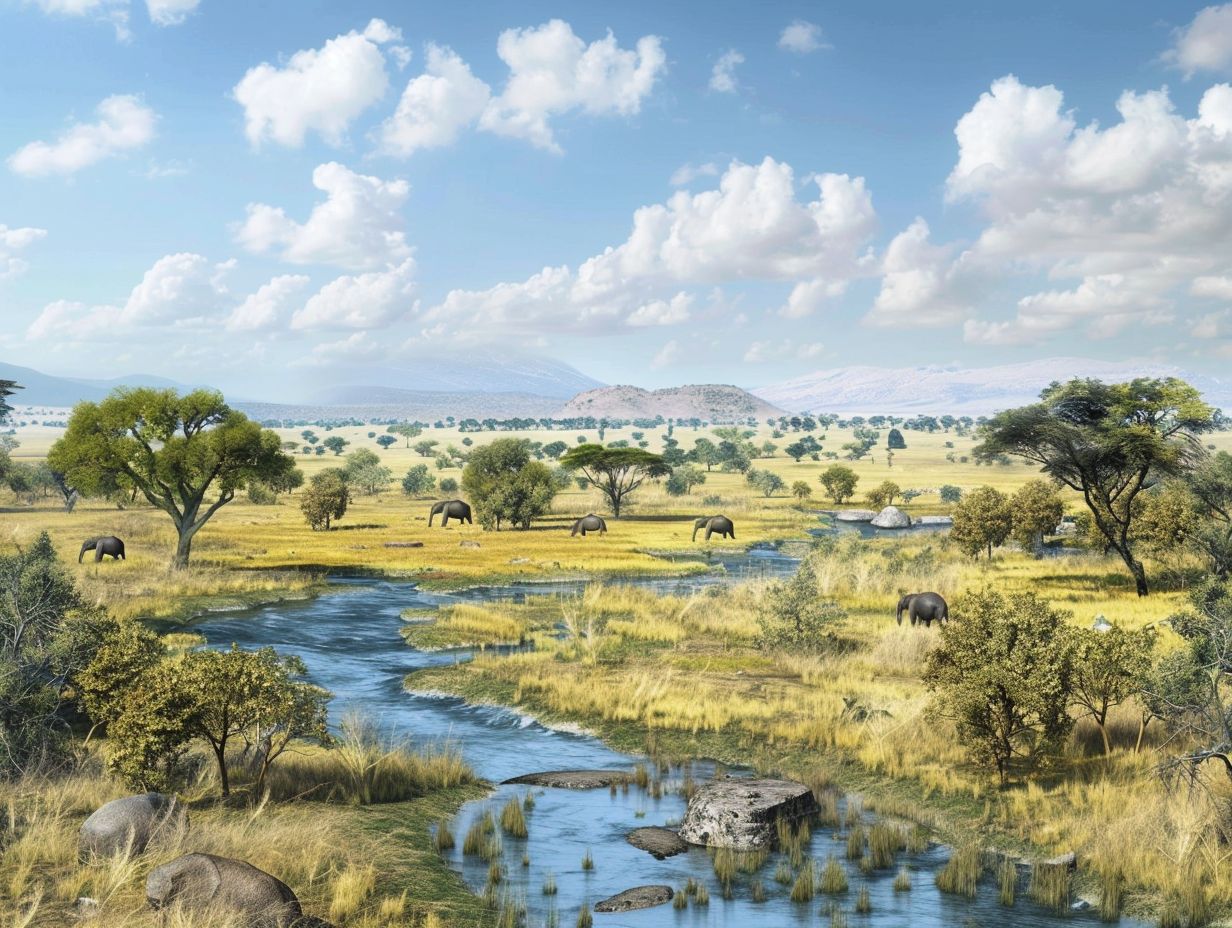
Katavi National Park
Welcome to Katavi National Park, a hidden gem in Tanzania that boasts remote and untouched wilderness, diverse ecosystems, and an abundance of wildlife.
Discover the location and size of the park, its rich history, and what makes it truly unique.
From popular activities like game drives and walking safaris to the best time to visit and accommodations available, we provide you with all the information you need to plan your unforgettable trip to Katavi National Park.
Key Takeaways:

- Katavi National Park is a remote and untouched wilderness, making it a unique and off-the-beaten-path destination.
- The park boasts diverse ecosystems, from floodplains to woodlands, and is home to an abundance of wildlife, including large herds of elephants and buffalo.
- Activities in Katavi National Park range from game drives and walking safaris to bird watching and cultural visits, providing a well-rounded safari experience.
Location and Size of Katavi National Park:
Katavi National Park is located in the western part of Tanzania, known for its vast wilderness and diverse wildlife. Covering an area of approximately 4,471 square kilometers, the park is centered around Lake Katavi and the seasonal rivers like Chada River and Katuma River, offering a stunning natural landscape for visitors to explore.
The park’s remote location and limited accessibility have helped to preserve its pristine environment, making it a haven for a wide variety of wildlife including elephants, lions, hippos, and crocodiles. The combination of woodlands, floodplains, and miombo forests creates a diverse habitat that supports an abundance of species.
- Flora: Katavi National Park boasts a unique ecosystem with rare plants like wild palms and acacia trees dotting the landscape.
- Fauna: Visitors can witness large herds of buffalo and antelope, along with elusive predators like leopards and wild dogs roaming freely in the park.
- Birdlife: The park is also a paradise for bird enthusiasts, with over 400 species of birds recorded, including raptors and colorful waterbirds.
History of Katavi National Park:
The history of Katavi National Park dates back to its establishment as a protected area in Tanzania, aimed at preserving the rich wildlife and unique habitats found within its boundaries. Over the years, the park has played a crucial role in conservation efforts, safeguarding various species and their natural environments.
Initially established in 1974, Katavi National Park covers approximately 4,471 square kilometers and is nestled in the western part of Tanzania. The park’s creation was a response to the escalating threats posed to wildlife populations and habitats due to human activities and land use changes.
Since its inception, Katavi has served as a sanctuary for a variety of species, offering a safe haven for elephants, lions, hippos, and numerous bird species. The protection and management strategies implemented within the park have significantly contributed to the preservation of its biodiversity and ecosystem balance.
What Makes Katavi National Park Unique?
Katavi National Park stands out for its unique combination of abundant wildlife, including diverse animal species, large herds of mammals, and numerous bird populations. The park serves as a sanctuary for various migratory animals and provides essential reserves that contribute to the protection and preservation of these precious natural resources.
Distinctively, the park’s pristine wilderness and remote location offer visitors an unspoiled and authentic safari experience. With its vast floodplains, dense woodlands, and seasonal lakes, Katavi showcases a variety of habitats that support a wide array of flora and fauna.
The park’s conservation initiatives focus on maintaining the delicate balance of its ecosystems and safeguarding the habitats of endangered species such as lions, elephants, and hippos. This commitment to conservation underscores Katavi National Park’s vital role in sustaining biodiversity and promoting ecotourism in Tanzania.
-
Remote and Untouched Wilderness:
One of the defining characteristics of Katavi National Park is its remote and untouched wilderness, offering visitors a glimpse into the unspoiled beauty of nature. The park’s spirit truly resonates through its vast landscapes, majestic tamarind trees, and the sense of tranquility that envelops Katabi.
As you venture deeper into the heart of Katavi, you’ll find yourself surrounded by a tapestry of colors painted by the countless species of flora that call this park home. Among these treasures, the tamarind tree stands out with its elegant stature and unique presence. These trees not only add to the park’s scenic beauty but also play a vital role in maintaining the delicate balance of its ecosystem.
The gentle rustling of leaves and the occasional chirping of birds create a harmonious symphony that adds to the serene atmosphere, truly capturing the essence of Katavi’s spirit.
-
Diverse Ecosystems:
Katavi National Park boasts a rich tapestry of diverse ecosystems, ranging from lush vegetation to varied habitats that support a wide array of wildlife species. These ecosystems play a vital role in shaping animal behaviors, providing essential corridors for movement, and fostering a harmonious coexistence within the park.
The park showcases a unique blend of vegetation types, from dense woodlands to open grasslands, creating ideal homes for different animal species. The diverse habitats, including floodplains, acacia woodlands, and seasonal lakes, offer a variety of niches for wildlife to thrive.
These interconnected ecosystems not only sustain a high biodiversity but also reveal the delicate balance of nature’s intricate web. The presence of river systems further enhances the park’s allure, attracting numerous species of birds and mammals seeking water sources.
-
Abundance of Wildlife:

Katavi National Park is renowned for the abundance of wildlife it harbors, with a plethora of animal species thriving in this sanctuary. The park’s conservation efforts, protective reserves, and habitat management strategies have created a safe haven for diverse wildlife populations to flourish.
Among the captivating creatures that call Katavi National Park home are the majestic elephants, graceful giraffes, elusive leopards, and regal lions. The park’s lush plains and winding rivers provide the perfect backdrop for these magnificent animals to roam freely. With stringent anti-poaching measures and conservation programs in place, endangered species like the African wild dog and hippos find refuge in this biodiverse haven.
Popular Activities in Katavi National Park:
Visitors to Katavi National Park can partake in a variety of popular activities that cater to different interests and preferences. From thrilling game drives and immersive birding safaris to captivating walking safaris and enriching cultural visits, there is something for every visitor to enjoy.
Game drives in Katavi National Park offer a heart-pounding adventure where visitors can witness the raw beauty of the African wilderness up close. Traversing through the rugged terrain, one may encounter a plethora of wildlife, including majestic lions, elegant giraffes, and graceful elephants.
On birding safaris, enthusiasts can marvel at the diverse avian species that call the park their home. The melodious tunes of colorful birds fill the air, creating a symphony of nature that is both soothing and invigorating.
For those seeking a more intimate experience with nature, walking safaris provide the perfect opportunity to immerse oneself in the sights, sounds, and scents of the bush. Expert guides lead guests through the untamed landscape, unveiling hidden treasures and sharing fascinating insights about the flora and fauna.
Cultural visits in Katavi National Park offer a unique glimpse into the traditional way of life of local communities. From interacting with tribespeople to learning about age-old customs and traditions, these visits allow visitors to gain a deeper understanding of the rich cultural heritage that thrives in the region.
-
Game Drives:
Game drives in Katavi National Park provide visitors with an unparalleled opportunity to witness the mesmerizing wildlife spectacle up close. From herds of majestic elephants to graceful giraffes, the park’s diverse fauna offers a captivating experience for wildlife enthusiasts and nature lovers alike.
As the safari vehicle traverses the savannah plains, eager eyes scan the horizon for a glimpse of the elusive lions or the graceful antelopes. The encounters with these animals, each uniquely adapted to their environment, offer a profound connection to the natural world. Engaging in these game drives not only allows for thrilling wildlife viewing but also fosters a deep appreciation for the delicate balance of ecosystems within the park.
-
Walking Safaris:
Embarking on walking safaris in Katavi National Park offers a unique perspective on the park’s wilderness, allowing visitors to connect intimately with nature. The experience of trekking through the remote beauty of the park and encountering wildlife in their natural habitat is both thrilling and enriching.
What sets walking safaris in Katavi National Park apart is the immersive nature of the experience. As you traverse the untamed terrains on foot, each step unveils a newfound sense of connection with the environment. The rustling of leaves, the distant calls of wildlife, and the rustling of grass create an orchestra of wilderness sounds that engulf you in a symphony of nature.
Exploring the park on foot allows for a deeper appreciation of the intricacies of the ecosystem. Observing the intricacies of wildlife behavior, from the majestic movements of elephants to the subtle signs of smaller creatures, offers a profound insight into the interconnectedness of all living beings.”
-
Bird Watching:
Bird watching enthusiasts flock to Katavi National Park to admire the diverse avian species that grace its skies and habitats. From elegant herons to migratory birds, the park offers a haven for birders to observe unique species and witness fascinating behaviors in a natural setting.
Visitors can spot an array of bird species in Katavi National Park, such as African fish eagles soaring above the rivers, vibrant lilac-breasted rollers perched on tree branches, and majestic saddle-billed storks wading in the marshlands. The park’s wetland habitats attract an abundance of waterfowl, including African jacanas gliding gracefully across the water’s surface.
During the peak birding seasons, the skies come alive with the fluttering of countless winged creatures, making it a paradise for bird enthusiasts seeking rare sightings and memorable experiences. Birdwatching expeditions in Katavi National Park offer a serene escape into nature, providing opportunities to appreciate the beauty and diversity of avian life.
-
Cultural Visits:
Cultural visits in Katavi National Park offer visitors a chance to delve into the rich history and heritage of the region, exploring local traditions, customs, and attractions. From ancient sites to indigenous communities, these visits provide an immersive cultural experience that enhances the overall journey through the park.
By interacting with the local communities, visitors can gain insight into centuries-old traditions, witness traditional ceremonies, and even participate in activities that have been passed down through generations. The authenticity of these experiences allows guests to connect on a deeper level with the land and its people, fostering a sense of appreciation for the cultural tapestry woven into the fabric of Katavi National Park.
Best Time to Visit Katavi National Park:

The best time to visit Katavi National Park largely depends on the seasonal variations that impact wildlife sightings and park experiences. While the dry season offers excellent opportunities for game viewing and witnessing large herds of animals, the wet season transforms the landscape into a lush paradise with abundant birdlife and stunning greenery.
During the dry season, typically from May to October, the sparse vegetation and limited water sources concentrate wildlife around the remaining watering holes, providing visitors with remarkable encounters with lions, elephants, and buffalo, among other species.
In contrast, the wet season, from November to April, showcases a different side of Katavi National Park. The rejuvenating rains bring about a burst of greenery, attracting a plethora of bird species and filling the air with their melodious calls. Exploring the park during this time offers a unique perspective on its ecosystem and the interplay between different species.
-
Luxury Lodges:
Luxury lodges in Katavi National Park offer discerning visitors a high-end accommodation experience amidst the wilderness, blending comfort with exclusivity. From elegant suites to personalized services, these lodges provide a luxurious retreat for guests seeking a premium safari getaway.
Guests can indulge in spa treatments amidst the serene surroundings, unwind in infinity pools overlooking breathtaking landscapes, and savor gourmet cuisine prepared by top chefs.
The attention to detail in every aspect of the stay ensures a seamless and opulent experience. Along with the lavish amenities, lodges in Katavi National Park organize exclusive guided safaris to witness the diverse wildlife up close. The tariffs for these upscale accommodations reflect the unparalleled quality and service provided, ensuring each guest receives exceptional value for their investment.
-
Tented Camps:
Tented camps in Katavi National Park offer a unique lodging experience that combines the charm of camping with the comforts of modern amenities. Nestled within the wilderness, these camps provide an authentic safari ambiance for visitors seeking a closer connection to nature at budget-friendly rates.
Accommodation options in these tented camps range from cozy canvas tents to spacious safari suites, allowing guests to choose based on their preferences. The camping facilities include communal areas for dining and relaxation, often featuring open-air boma fire pits for social gatherings under the starlit African sky.
The immersive safari experience at these campsites lets travelers witness the raw beauty of Katavi National Park’s wildlife up close, with expert guides leading game drives and walking safaris through the untamed landscapes.
-
Budget Campsites:
Budget campsites in Katavi National Park cater to cost-conscious travelers looking for affordable yet comfortable lodging options amidst the park’s wilderness. These campsites provide basic amenities, stunning natural surroundings, and a genuine safari experience that aligns with budget-friendly travel preferences.
Staying at these simple yet charming campsites not only allows visitors to save on accommodation costs but also offers a unique opportunity to immerse themselves in the heart of the African bush. With the sounds of wildlife as a lullaby and the starlit sky as a canopy, guests can truly disconnect from the hustle and bustle of modern life.
The proximity of these budget campsites to prime wildlife viewing areas enhances the chances of up-close encounters with majestic creatures, from elephants and giraffes to lions and buffalo. The thrill of waking up to the sight of a wandering herd or catching a glimpse of a rare bird species adds an authentic touch to the overall safari experience.
Conservation Efforts in Katavi National Park:
The conservation efforts in Katavi National Park play a pivotal role in safeguarding the park’s biodiversity, protecting critical habitats, and preserving the delicate balance of its ecosystems. Through dedicated management practices, habitat conservation, and the establishment of wildlife corridors and reserves, the park continues to uphold its commitment to sustainable conservation practices.
One of the key strategies employed in Katavi National Park is the creation of buffer zones around sensitive habitats to minimize human-wildlife conflicts and maintain ecological integrity.
The park focuses on implementing anti-poaching measures, monitoring wildlife populations, and conducting research to inform conservation decisions. By integrating local communities into conservation efforts through education and sustainable resource management, Katavi National Park fosters a sense of shared responsibility for the preservation of its natural heritage.
How to Get to Katavi National Park?
Getting to Katavi National Park involves various transportation options that cater to different travel preferences and starting points. Whether the visitors choose to fly into nearby locations like Mbeya town, Arusha town, or Dar es Salaam, or opt for road transportation, there are convenient ways to reach this remote wilderness destination.
For those who prefer air travel, flying into Mbeya town offers a quick access point to Katavi National Park. Arusha town, known as the gateway to many Tanzanian national parks, also serves as a starting point for those seeking a picturesque flight to Katavi. Alternatively, flying into Dar es Salaam provides a more extensive flight network, connecting travelers from various international destinations.
On the other hand, road transportation allows visitors to experience the scenic beauty of Tanzania’s landscapes on the journey to Katavi. The park is accessible by road, with options for guided tours or self-drive adventures, giving travelers the flexibility to explore at their own pace.
Wildlife Diversity in Katavi National Park:

Katavi National Park is a haven for wildlife enthusiasts, boasting a remarkable diversity of animal species and bird populations. From graceful giraffes and majestic elephants to stealthy leopards and formidable buffaloes, the park offers unparalleled opportunities for game viewing and wildlife encounters amidst its lush vegetation and thriving ecosystems.
The park is renowned for its thriving populations of crocodiles and hippos, creating a spectacular spectacle for visitors. The sight of these majestic creatures basking in the sun along the riverbanks is truly mesmerizing. Along with the impressive array of wildlife, the vegetation within the park plays a crucial role in supporting this rich biodiversity.
The dense woodlands, floodplains, and seasonal lakes provide a diverse habitat for a wide range of species, from the smallest insects to the largest predators. Exploring the varied landscapes of Katavi National Park offers a profound insight into the intricate web of life that exists within this pristine wilderness.
Frequently Asked Questions:
1. What is Katavi National Park?
A: Katavi National Park is a national park located in Tanzania, East Africa. It covers an area of 4,471 square kilometers and is known for its diverse wildlife and stunning landscapes.
2. What is the best time to visit Katavi National Park?
A: The best time to visit Katavi National Park is during the dry season, which runs from May to October. This is when the wildlife is concentrated around water sources, making it easier to spot animals.
3. What kind of animals can be found in Katavi National Park?
A: Katavi National Park is home to a wide variety of animals, including elephants, buffalo, giraffes, zebras, lions, leopards, hippos, crocodiles, and many more. It is also a great place for bird watching, with over 400 bird species recorded in the park.
4. Is it safe to visit Katavi National Park?
A: Yes, it is safe to visit Katavi National Park. The park is well-managed and has a low crime rate. However, it is always important to follow the park rules and guidelines and to be cautious when encountering wild animals.
5. What activities can be done in Katavi National Park?
A: Visitors to Katavi National Park can enjoy a variety of activities, including game drives, walking safaris, bird watching, and boat safaris. There are also several camps and lodges within the park for accommodation.
6. How do I get to Katavi National Park?
A: The main airport for accessing Katavi National Park is in the city of Mbeya. From there, you can take a domestic flight to the park’s airstrip. Alternatively, you can also drive to the park from Mbeya, which takes approximately 8 hours.